Last updated on April 17, 2024

Skyclave Apparition | Illustration by Donato Giancola
Modern is easily the most popular competitive format in Magic here in the UK. We had regular Modern events with huge prizes courtesy of the UK powerhouse LGS: Axion Now before the pandemic hit us like a brick, and they’d always sell out for anywhere up to 300 players.
Modern is arguably one of, if not the most played Eternal format. It has more card availability than Legacy or Vintage and no restrictions from the Reserved List, and it’s a former Pro Tour Format. Modern has been frequently shaken up not only from Standard printings, but also from sets designed with Modern in mind, like the Modern Horizons sets (expecting a shake up with Modern Horizons 3) and Lord of the Rings: Tales from Middle-earth.
This last release in particular introduced staples to the format, like Orcish Bowmasters and The One Ring, and it’s up to discussion whether these cards are warping the format in a way that they should be banned. Even with constant reprints, the format gets more staples than the reprint rate, and even for reasonably well-off people with disposable income, the thought of dropping over $1,000 on a deck of Magic cards is a daunting one at best.
I run the Magic events at a brand-new local game store as my day job, and one of the biggest hurdles I’ve had to face is getting new players interested in Constructed. Limited formats are fairly easy to get into. Commander has dozens of cheap and affordable preconstructed decks. Constructing EDH for cheap is doable. Building Commander is even easier with a budget closer to $100. But how does anyone get started in Standard, Pioneer, or Modern?
I’m going to answer that question and provide you with some options for jumping into Modern with a small budget. Let’s get started!
How Can I Buy a Full Deck for Under $100?

Cavern of Souls | Illustration by Richard Wright
Top-tier competitive decks are out of the question unless you’re able (and willing) to spend a good deal more money than this, but who said you have to be doing the most competitive thing possible to have fun and enjoy playing Magic? There are a few easy ways to avoid paying so much up front to enjoy Modern.
Mana Bases
Most of the top Modern decks are expensive because of their lands. Even after another round of reprints earlier this year, fetch lands still cost a lot of money, around $100 per playset. Not to mention that you also need shock lands, Triomes, and sometimes even lands like Cavern of Souls that really do a number on your bank balance.
4-color Yorion Blink, a deck that boasts some of the most expensive nonland cards in the whole format and a whopping 16 fetch lands, has become prominent in the last few months. All of these expenses add up very quickly. You can avoid this by looking at mono-color decks or decks that use color combos with much cheaper dual lands available.
If you want to understand the fundamentals of Modern deck construction, Reid Duke covers this in depth in his course on Modern for Spikes Academy.

Heavy Hitters
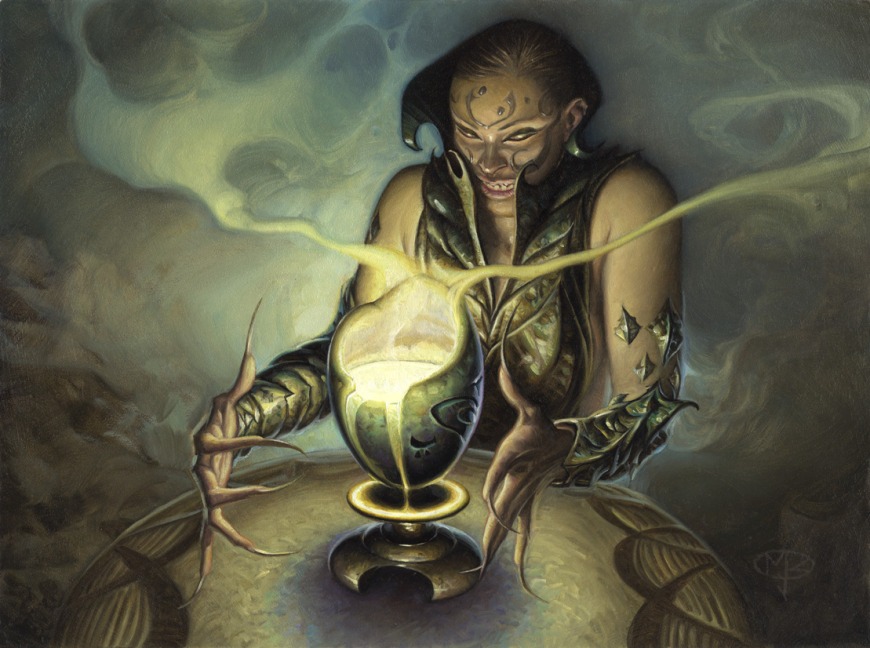
Chalice of the Void | Illustration by Mark Zug
Ragavan, Nimble Pilferer, Chalice of the Void, Wrenn and Six, Force of Negation, and Solitude are some of the most expensive cards around. Some of these would go over your budget if you included just a single copy. A lot of the top decks revolve around these cards, so you can’t just take the top builds and expect to find suitable replacements on a budget,
But what you can do is look at decks that are centered around cheap cards. There are plenty of great cards out there for a few bucks that are good enough to build around.
Cheap Deck Cores
As a follow-up on both of these points, there are some very powerful Modern decks that are actually very cheap to build but have a single expensive playset or an expensive mana base. A good strategy to get into Modern can be to invest in the basic core of a deck, fill the gaps in with more affordable options, and then buy the more expensive pieces over time. Another tip is that Modern and Pioneer share lots of staples, so sometimes you’ll be able to carry your Pioneer deck into Modern with a few changes, or at least some staples like Fatal Push, Thoughtseize, and Monastery Swiftspear.
A few of the options I give here go with this strategy, and it’s one I’ve used many times when looking to get a new deck.
Redundancy

Solitude | Illustration by Evan Shipard
If you have a bit more money and want to look at getting something more expensive, a great way to approach this (or any other) format is to look at staples that overlap across multiple decks. If you buy a set of Solitudes, you can play them in a wide variety of Modern decks and they’re usually a welcome addition to any white deck you build in the format.
You can generally end up with multiple decks without spending much more than you spent for just the one if you look at cards that overlap across a number of decks.
Sideboards
I tend to look at Constructed decks as being just 60 cards and ignore the sideboard. It’s a bad habit that stuck with me from my days as a teenager playing Yu-Gi-Oh where many players didn’t bother with it or had no idea how to do it. But sideboards aren’t necessary to get started with a Constructed deck, and many of them can be built on the cheap for every deck.
Soul-Guide Lantern and Lantern of the Lost are both very recent printings that serve as perfectly fine graveyard hate for any deck. I’m going to skip sideboards on most of these decks since that’s a step that can be added later based on what decks you come up against in your local metagame.
Put It All Together: Budget Deck Options
All this advice is fine, but what are some examples of putting these points into practice? Let’s look at some great contenders for your first Modern deck. You might not be winning any huge tournaments with these, but that’s not going to be enough to stop you from taking down a local FNM or having fun with friends.
Let’s just jump right in!
Soul Sisters

Soul Warden | Illustration by Randy Gallegos
Creature (28)
Lunarch Veteran x4
Soul Warden x4
Soul's Attendant x4
Speaker of the Heavens x3
Ajani's Pridemate x4
Voice of the Blessed x4
Heliod, Sun-Crowned x2
Righteous Valkyrie x3
Instant (6)
Path to Exile x4
Valorous Stance x2
Enchantment (2)
Land (24)
Plains x18
Shefet Dunes x2
Windbrisk Heights x4
Themes, Strategy, and Budget
I’ve been playing Magic since a little before the start of the Modern format. I have fond memories of playing with Soul Sisters and getting horrifically crushed by it.
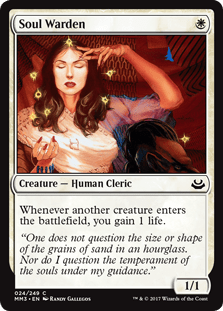
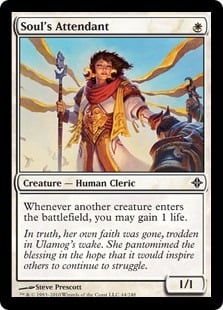
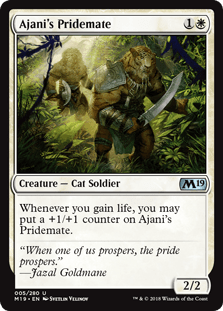
The name comes from Soul Warden and Soul's Attendant, two virtually identical versions of the same card. The idea is not to gain as much life as possible but to benefit from gaining life several times, triggering Ajani's Pridemate each time.


I haven’t seen this deck for quite some time, but what got me thinking about it again was the printing of Voice of the Blessed in Crimson Vow, a brand-new version of Ajani's Pridemate which should give the deck some more power. The recent printing of Righteous Valkyrie should also give the list a nice boost and a much stronger late game, allowing you to turn your Soul Sisters into potent attackers in their own right.
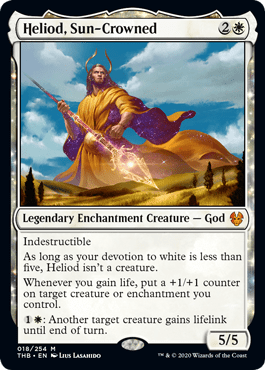
Finally, though a slightly more expensive card, Heliod, Sun-Crowned is perfect for a deck that aims to gain life several times in a single turn. You do have to make a few decisions to make this work, but a version of this is very achievable on a budget.
Soul Sisters comes in at just under $100. It’s by no means perfect but it’s very functional.
There are a few nice additions that you can make with a higher budget, too. More copies of Heliod, Sun-Crowned would be my first stop since they can also be used to build the infinite combo decks that combine Heliod with Spike Feeder or Walking Ballista.
Auriok Champion is a much more powerful soul sister than Lunarch Veteran since protection from red and black makes it immune to almost all of the removal in the format. Giver of Runes and Ranger-Captain of Eos are nice options used by many white decks in the format to help protect you against heavy disruption.
Finally, Skyclave Apparition would be a very welcome inclusion as one of the best removal spells white has access to, and you might even have it in your collection already.
The core of this deck is essentially a classic white weenie deck. Being mono-white, a natural progression is to eventually convert it into one of the best mono white decks in Modern: Death and Taxes.
Some of the cards I’ve mentioned slot right into both decks. You also have the option of leaning hard into the Heliod combo and building Mono White Heliod Devotion, a deck that was big in the metagame until 2021. This deck leans heavily on trying to assemble Heliod and Walking Ballista for infinite damage while having a deck full of solid, powerful cards to tackle other decks.
I also wanted to give a shoutout to “Martyr Proc,” a similar-looking white control deck centered around Martyr of Sands. This build looks to gain absurd amounts of life while beating down with Serra Ascendant and infinitely recurring Martyr with either Emeria, the Sky Ruin or Proclamation of Rebirth. This is another deck that’s built around lifegain shenanigans and can be built fairly cheap.
But Serra Ascendants go for around $24 each. Other than those, the deck can be built well on a low budget. So if you already have these cards or can find a cheap playset, this is definitely an option for you.
“8-Whack”

The Rack | Illustration by Nic Klein
I found this decklist in the top 8 of a Magic Online event in late 2021 from user davidbrito:
Creature (33)
Foundry Street Denizen x4
Goblin Bushwhacker x4
Goblin Guide x4
Legion Loyalist x4
Mogg Fanatic x4
Battle Cry Goblin x4
Goblin Piledriver
Mogg War Marshal x4
Reckless Bushwhacker x4
Instant (4)
Sorcery (4)
Land (19)
Castle Embereth x4
Mountain x15
Sideboard (15)
Tormod's Crypt x3
Cleansing Wildfire x3
Dragon's Claw x2
Ratchet Bomb x2
Reality Hemorrhage x2
Smash to Smithereens x2
Void Mirror
Themes, Strategy, and Budget
A pretty cheap deck featuring everyone’s favorite tribe of annoying little red creatures is 8-Whack. The name is a pun on the popular mono-black deck “8-Rack” that wins by combining discard spells with eight copies of The Rack, with copies five through eight being Shrieking Affliction.
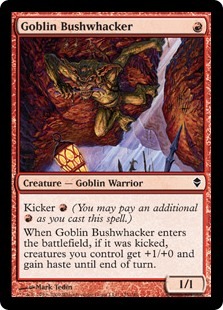

In this version of deck you have eight Bushwhackers (four copies each of Goblin Bushwhacker and Reckless Bushwhacker) which each pump your horde of goblins and give them all haste. The majority of the cards in 8-Whack are commons and uncommons, so you even have room in your $100 budget for a few nice rares.
Clocking in at just under $90, this deck gives you a lot of bang for your buck. The game plan is very simple: play goblins and attack with them.
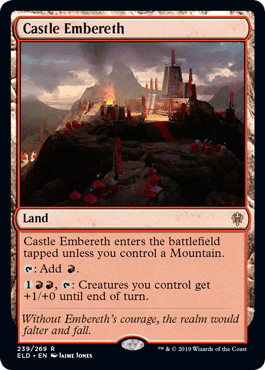
Your eight Bushwhackers give you great ways to push a board of goblins through defenses and Castle Embereth even gives you a similar effect on a land.
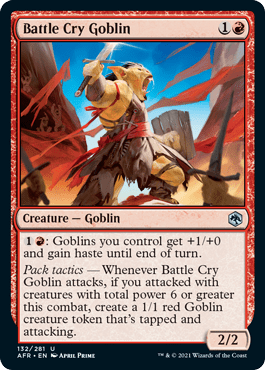
Perhaps the biggest payoff in this deck though is the newest addition of Battle Cry Goblin from Forgotten Realms. This can be four more Bushwhackers later in the game, albeit for twice the mana. But when you draw and play it early it can act as one of the decks' only ways to gain free card advantage. Not only that but the Bushwhackers themselves give you a really easy way to enable its pack tactics ability.
Boros Burn
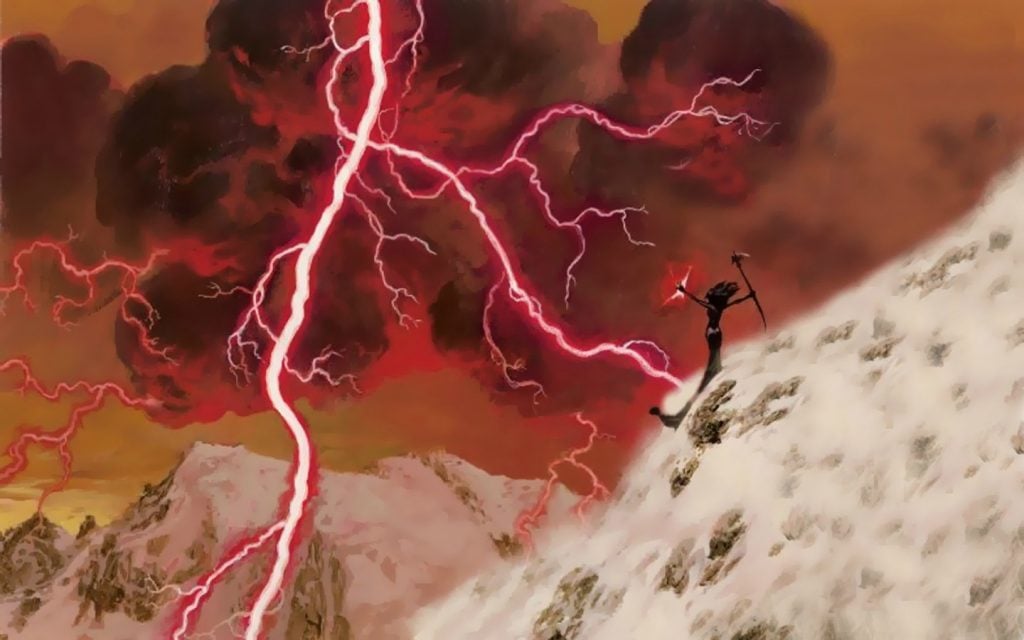
Lightning Bolt | Illustration by Christopher Moeller
Take a look at the following decklist that topped a Modern Challenge in the hands of jamiieJR in late 2021:
Creature (12)
Goblin Guide x4
Monastery Swiftspear x4
Eidolon of the Great Revel x4
Instant (17)
Lightning Bolt x4
Boros Charm x4
Lightning Helix x3
Searing Blaze x4
Skullcrack x2
Sorcery (12)
Lava Spike x4
Rift Bolt x4
Skewer the Critics x4
Land (19)
Arid Mesa x2
Bloodstained Mire x2
Inspiring Vantage x4
Mountain x3
Sacred Foundry x2
Scalding Tarn x2
Sunbaked Canyon x4
Sideboard (15)
Path to Exile x3
Deflecting Palm x2
Roiling Vortex x3
Sanctifier en-Vec x3
Skullcrack
Smash to Smithereens x3
Themes, Strategy, and Budget
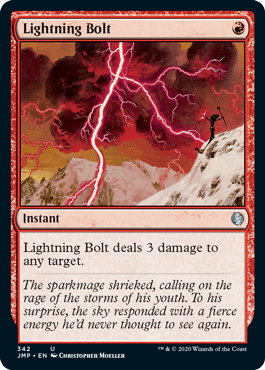
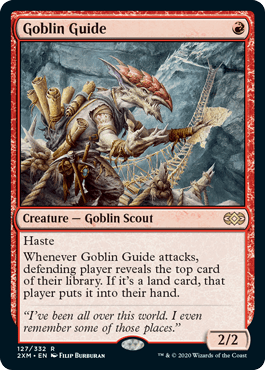
This can be a very good place to start if you’re getting into Modern, and it even lets you do so while buying two of Modern’s biggest staple cards: Lightning Bolt and Goblin Guide, which both overlap with Burn.
Boros Burn has been a mainstay of Modern for pretty much as long as I can remember and it’s still one of the top decks of the format. This exact Boros Burn list could set you back over $500, but around $400 of that is in the mana base alone.
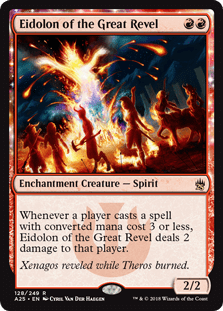
You already have Bolts and Guides if you grabbed 8-Whack. Eidolon of the Great Revel is the next big purchase, but the main deck is very cheap to put together other than that.
You could even just build it without the white to get you started and then slowly build up to getting the Boros () dual lands necessary to make the deck work. You could even use different duals that you already own, like Needleverge Pathway or Battlefield Forge, until you get the better ones.
Red Deck Wins Variation
Creature (14)
Keldon Marauders x3
Goblin Guide x4
Monastery Swiftspear x4
Bolt Hound
Wayward Guide-Beast x2
Instant (7)
Shard Volley
Lightning Bolt x4
Skullcrack x2
Sorcery (18)
Flame Rift x4
Lava Spike x4
Rift Bolt x4
Forked Bolt
Light Up the Stage
Skewer the Critics x4
Enchantment (1)
Land (20)
Mountain x16
Ramunap Ruins x4
Sideboard (15)
Blood Moon
Magus of the Moon
Smash to Smithereens x2
Searing Blaze
Searing Blood x2
Leyline of Combustion x3
Jegantha, the Wellspring
Soul-Guide Lantern x4
This is a mono red variation on an even smaller budget. It was able to 5-0 a Modern League in the hands of DemianDesposito10 in July, 2023. Red Deck Wins is an archetype that combines burn spells with efficient haste creatures. This decklist is playing Monastery Swiftspear, Goblin Guide, and Wayward Guide-Beast, which can pack a punch early and backs up the aggression with burn spells like Shard Volley, Lightning Bolt, and Skullcrack. We also have creatures like Keldon Marauders which usually deals 2 damage to an opponent by itself and Bolt Hound to pack a punch when attacking with friends.
As with almost all burn decks and cheap decks, redundancy is key. There are some differences between Wayward Guide-Beast, Lava Spike, and Skewer the Critics, but they can all deal 3 damage to an opponent while costing a single mana to cast. This decklist can be built with around $70 or 35 Tix on MTGO.
Mono Green Stompy
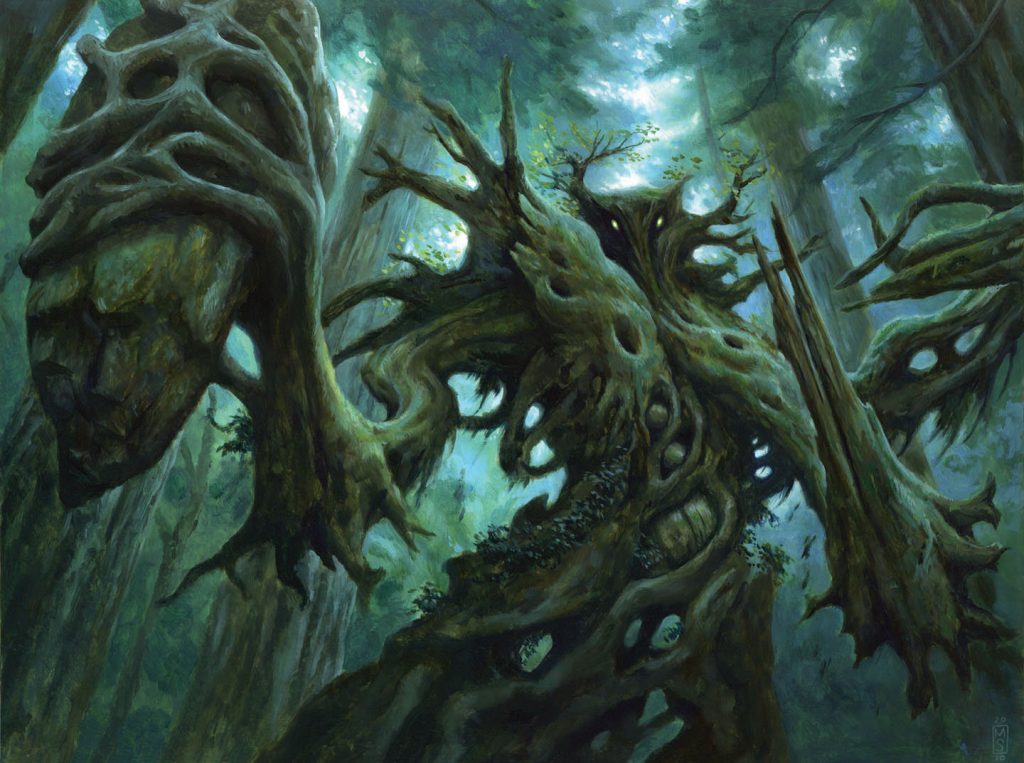
Dungrove Elder | Illustration by Matt Stewart
Creature (29)
Experiment One x4
Pelt Collector x4
Avatar of the Resolute x4
Scavenging Ooze
Strangleroot Geist x4
Werewolf Pack Leader x4
Steel Leaf Champion x4
Yorvo, Lord of Garenbrig x4
Instant (8)
Aspect of Hydra x4
Blossoming Defense x4
Enchantment (4)
Rancor x4
Lands (19)
Hashep Oasis x3
Forest x16
Themes, Strategy, and Budget
For those of you who play or follow Standard, you’re probably be familiar with the mono green deck that’s been stomping around the top tables the last few months. There was a fairly similar deck back in the earlier days of Modern.
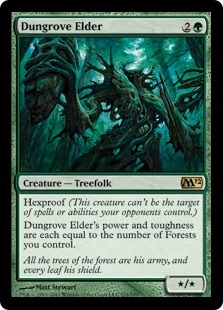
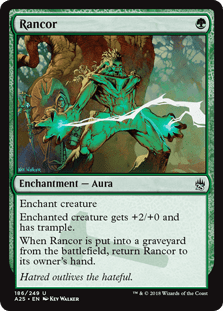
The idea was to use the oh-so-annoying Dungrove Elder, give it trample (probably with a Rancor), and start going to town.

Primal Bellow also acted as a huge Giant Growth to make sure combat always went in your favor.
Nowadays many of these cards have been made obsolete, but WotC did a good job of printing a lot of very powerful and efficient green aggro creatures, so you can definitely make a deck with them work.
This Mono Green Stompy deck doesn’t even break the $50 mark, meaning you’d even have room to make a strong sideboard out of whatever you wanted.

Werewolf Pack Leader is responsible for 40% of the value here and it’s well worth every penny as you might have seen from Standard. Aggro decks will always struggle with card advantage and having a 2-drop be able to draw you extra cards while also providing two pips for devotion and being a 3/3 is an incredible little package. It’s literally everything this deck could have ever wanted in a 2-drop.
But you won’t find any other Modern decks that overlap with this, so there isn’t a clear upgrade path like with the others. If you play a bit of Standard or Draft, though, you may already have the Pack Leaders, and the rest of the deck is extremely cheap from there.
HollowVine

Vengevine | Illustration by Raymond Swanland
This list went 5-0 in a Modern League in the hands of contagion13 in late 2021:
Creature (32)
Asmoranomardicadaistinaculdacar x4
Blazing Rootwalla x4
Flameblade Adept x4
Insolent Neonate x4
Vengevine x4
Wonder
Hollow One x4
Ox of Agonas x3
Street Wraith x4
Sorcery (8)
Burning Inquiry x4
Goblin Lore x4
Artifact (3)
Land (17)
Arid Mesa
Bloodstained Mire x4
Copperline Gorge x4
Mountain x5
Steam Vents
Stomping Ground x2
Sideboard (15)
Lightning Axe
Lightning Bolt x2
Void Mirror
Blood Moon x3
Foundation Breaker x2
Leyline of the Void x4
Ingot Chewer x2
Themes, Strategy, and Budget
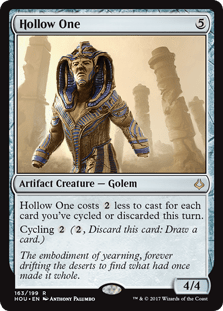
When Hollow One was first printed back in Hour of Devastation, it took Modern by storm. The deck that conjured around it was powerful, resilient, and downright nasty to play against.
Nowadays, the deck has drifted into the background, probably thanks to the banning of Faithless Looting. But some recent reprints of the more key ingredients have made the deck very affordable.

What caught my eye about this in particular is that it’s a mono red deck that only uses non-red lands to give you outs to hard casting cards like Vengevine. This means that with an all-Mountain mana base, the deck can perform just as smoothly in the vast majority of games that it plays.
The land base isn’t necessary to make the main deck tick. If you ignore that and just play 17 Mountains, the remaining HollowVine main deck only costs you around $80. You sadly also lose out on Wonder, but it’s not essential in the first place and can be cut for another Ox of Agonas, Mountain, or The Underworld Cookbook.
The sideboard does go over your budget thanks to Blood Moon and Leyline of the Void, but both could be subbed out for cheaper options.
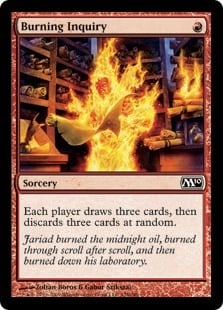
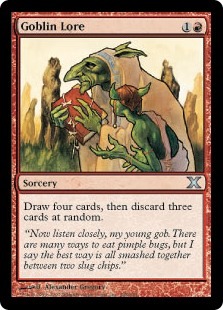

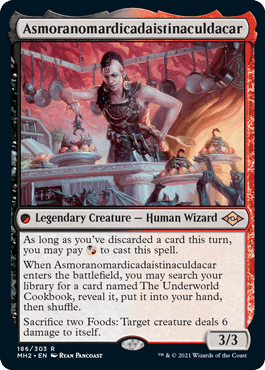
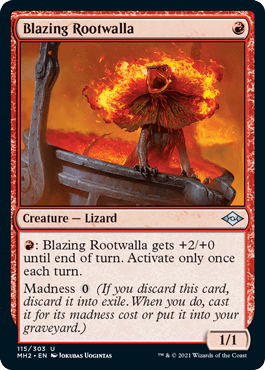
The strategy behind this deck is fairly simple: it’s all about discarding cards. If you resolve a Burning Inquiry or a Goblin Lore, you’ve discarded enough cards to make a single Hollow One cost zero mana. Asmoranomardicadaistinaculdacar is also castable for just a single mana and Blazing Rootwalla casts itself for free if you happened to discard it.
With all of this combined, you can easily flood the board with cheap or free creatures and any Vengevines you discarded along the way also jump into the fray. If it all starts going wrong, Ox of Agonas is available to help get you back into the game and start it all over again.
This deck has to be my number one pick for most annoying deck to play against. It looks like it would be weak to graveyard hate but then it just throws a bunch of creatures out of the hand and runs over you. Removal doesn’t work because it just has too many threats and you don’t usually have enough time to build up to a sweeper, of which you run scarily few since they’re just not that good in Modern.
If this sounds like it’s right up your alley, you could certainly do worse than this incredibly aggravating pile.
Storm
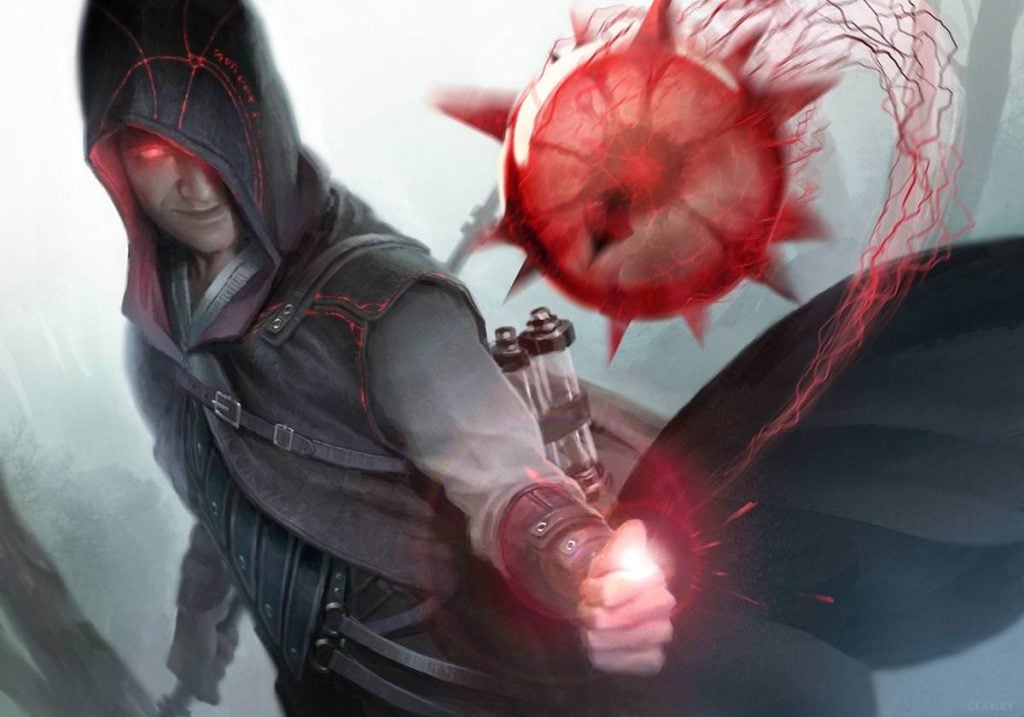
Grapeshot | Illustration by Clint Cearley
This list comes from MTGO user fsst who secured multiple 5-0 league finishes with this list in late 2021:
Creature (7)
Baral, Chief of Compliance x4
Goblin Electromancer x3
Instant (26)
Consider x4
Repeal
Desperate Ritual x4
Manamorphose x4
Pyretic Ritual x4
Remand x3
Silundi Vision x2
Gifts Ungiven x4
Sorcery (9)
Serum Visions x4
Grapeshot
Wish x2
Past in Flames x2
Land (18)
Fiery Islet
Island x2
Misty Rainforest x2
Mountain
Scalding Tarn x4
Snow-Covered Island
Spirebluff Canal x4
Steam Vents x3
Sideboard (15)
Lightning Bolt x3
Shattering Spree
Spell Pierce x2
Grapeshot
Blood Moon
Mystical Dispute
Pieces of the Puzzle x3
Empty the Warrens x2
Past in Flames
Themes, Strategy, and Budget
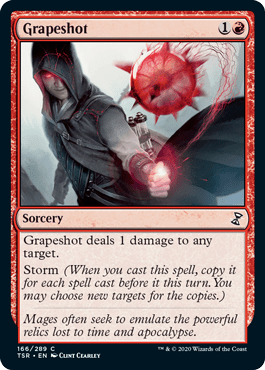
Storm has to be the most infamous combo deck in Magic’s history. It’s one of MTG’s most broken mechanics, and one that keeps sneaking its way back into new releases despite giving its name to the scale that WotC uses to determine whether a mechanic is too good to be reprinted. This classic deck has had many different versions over the years and formats, but it’s a straightforward Izzet () deck that combo kills using Grapeshot in Modern.

Storm decks are very difficult to get the hang of and have been the bane of my Magic career for years. The basic idea is that you want to use your first couple turns to sculpt your hand for a good combo turn using the blue draw spells. To combo off, you realistically need to have one of the seven creatures in your hand, which turn all of your red ritual spells into red Dark Rituals.
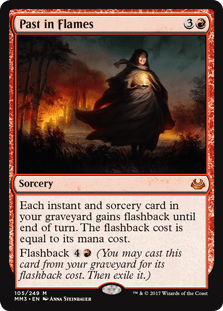
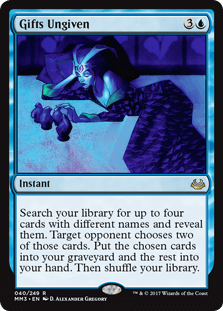
Having cast a bunch of these, Past in Flames lets you cast them all again, along with the blue spells that you used to set up. Gifts Ungiven looking for Past in Flames guarantees you getting it given that it has flashback and always goes to your hand or graveyard. There’s one copy of Grapeshot to win the game with.
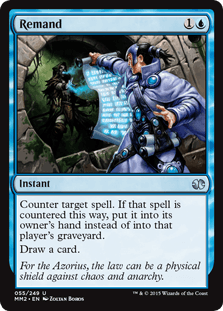
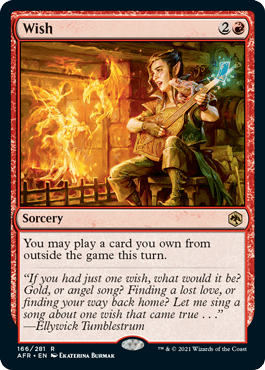
While a storm count of 20 sounds daunting, you can use Remand to return the original Grapeshot to your hand while the storm copies resolve and then recast it, getting you twice the amount of damage. Wish is also here to help you grab a storm spell from your sideboard, or to grab whatever other card you might need.
This entire Storm deck will set you back around $450 to $500, but I wouldn’t be talking about it if it wasn’t budget in some way. The main deck spells alone cost just $84. Some amount of the sideboard is necessary for Wish, but they’re also all relatively cheap cards except for Blood Moon.
It’s the mana base that gets tricky. While using fetches and shocks is the most ideal mana base for the deck, it’s by no means necessary. Cheaper dual land alternatives like Shivan Reef or Riverglide Pathway work just fine. You may even have some of these already.
Given that Storm has been a mainstay of Modern since day one, investing in this powerful combo deck should set you up on a good path as you venture into the format.
Twiddle Storm Variation
Creature (4)
Instant (20)
Twiddle x2
Dream's Grip x4
Reach Through Mists x4
Peer Through Depths x4
Psychic Puppetry x4
Impulse x2
Sorcery (16)
Eye of Nowhere
Ideas Unbound x4
Grapeshot x2
Sleight of Hand x3
Past in Flames x2
Serum Visions x4
Land (20)
Lonely Sandbar x4
Lotus Field x4
Island x12
Sideboard (15)
Boomerang
Nihil Spellbomb x2
Dispel
Echoing Truth x2
Mystical Dispute x2
Abrade x2
Empty the Warrens
Anger of the Gods
Counterspell
Tolarian Terror x2
This deck build by MTGO player Islandsmilego got to a 5-0 record in a Modern league in July, 2023. It’s based on cards that allow you to untap lands like Vizier of Tumbling Sands, Twiddle, and Dream's Grip, which are very cheap cards. You’ll then play a Lotus Field, which is able to generate 3 mana of any color, untap it while casting spells, and use the mana to draw more cards through cantrips (Sleight of Hand, Peer Through Depths). When you can go off, you’ll cast some spells, churn through your deck, find a Past in Flames, cast it, and then you should be able to recast your entire graveyard while constantly adding mana through Lotus Field. Casting Grapeshot once or twice will be enough to win from here.
What’s cheap about this deck is that not only your average card costs under a dollar, but the mana base is very cheap, consisting of mainly basic Islands, and you’ll get to add red through a couple Fiery Islets and Lotus Fields. This decklist doesn’t play shock lands or fetch lands. The sideboard options include going wide with Empty the Warrens or having a cheap threat in Tolarian Terror once people take out their sweepers and spot removal. This decklist can be built with around $50 or 60 Tix on MTGO. A more expensive version of this deck uses Twiddle with The One Ring as an engine to draw a bunch of cards and find what you need for your combo.
A Case for Blue-Black Mill
Planeswalker (2)
Creature (9)
Hedron Crab x4
Ruin Crab x4
Snapcaster Mage
Instant (18)
Archive Trap x4
Counterspell x2
Crypt Incursion
Drown in the Loch x2
Fatal Push x2
Surgical Extraction x3
Visions of Beyond x3
Test of Talents
Sorcery (10)
Fractured Sanity x4
Glimpse the Unthinkable x2
Tasha's Hideous Laughter x4
Land (21)
Field of Ruin x3
Flooded Strand x2
Island x4
Misty Rainforest x2
Otawara, Soaring City
Polluted Delta x2
Swamp x2
Verdant Catacombs
Watery Grave x3
Oboro, Palace in the Clouds
Sideboard (15)
Ashiok, Dream Render x2
Brazen Borrower x2
Ensnaring Bridge x2
Force of Negation x2
Leyline of the Void x4
Test of Talents
Unmoored Ego x2
Mill is one of those archetypes that, like burn and aggro decks, require redundancy. The last few sets have printed nice mill cards like Fractured Sanity, Tasha's Hideous Laughter, and Jace, the Perfected Mind. These cards helped to turn mill into a more consistent deck. This is an example of a decklist that uses mainly cheap cards to execute its gameplan, so it doesn’t rely on expensive staples like Thoughtseize, Jace, the Mind Sculptor or expensive win conditions. This decklist has an admittedly higher budget, but the expensive part is mainly in the mana base.
The strategy here is to lay down Hedron Crab or Ruin Crab and start milling players by playing lands. Spells like Fractured Sanity, Glimpse the Unthinkable, and Tasha's Hideous Laughter can mill large amounts of cards at once. This is a control deck, so you’ll be able to benefit from mill payoffs like Visions of Beyond and Drown in the Loch. Snapcaster Mage is a somewhat expensive staple, but here it’s a key player in this deck. You can use him to flashback mill spells and win, to counter a key spell, or to draw more cards. A new and key addition here is Jace, the Perfected Mind since it can ultimate on the spot and mill 15 cards, or mill three cards per activation while also being a mill payoff.
Aside from Archive Trap, the cards played by the deck are all cheap cards, and the mana base alone accounts for half the deck budget, which is around $450. Unfortunately, since this deck relies so much on landfall to be effective and mill players fast, it’s very hard to replace the fetch lands. They not only fix your mana and thin your deck, but they also trigger landfall twice. I can’t fully recommend replacing the fetch lands for basics and call it a day or advocate playing worse fetch lands like Evolving Wilds.
Enchantress

Sythis, Harvest's Hand | Illustration by Ryan Yee
Creature (12)
Destiny Spinner x4
Sanctum Weaver x4
Sythis, Harvest's Hand x4
Enchantment (28)
Abundant Growth x4
Mana Bloom
On Thin Ice x4
Utopia Sprawl x4
Sterling Grove x4
Borrowed Time x3
Enchantress's Presence x4
Solitary Confinement x3
Sigil of the Empty Throne
Themes, Strategy, and Budget
Perhaps one of the coolest archetypes to have come out of Modern Horizons 2, Enchantress is a fan favorite that’s periodically appeared in Legacy for decades.

The idea is that you can draw several cards every time you cast an enchantment spell thanks to Argothian Enchantress and Enchantress's Presence. You just need to use your newfound wealth to win a game somehow.
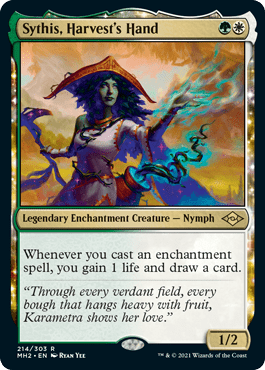
We don’t have Argothian Enchantress in Modern, but we do have Sythis, Harvest's Hand, which is even better in some ways since it’s an enchantment itself.
This deck tends to be Naya () colors, mainly green and white and splashing red for Blood Moon. As I mentioned already, this card is too expensive to include in your $100 budget, so this is a pure Selesnya () Enchantress deck.
This pile of forty Enchantress cards only costs you a little under $70. An ideal mana base is a little pricey, but you can get away with a budget one. Branchloft Pathways and Sunpetal Groves are fairly cheap and fit into this budget. If your budget can stretch a bit further, you can get some Temple Gardens and a fetch or two.
The only important thing to note with the land base is that you need to use Snow-Covered Forests and Snow-Covered Plains to make On Thin Ice work.

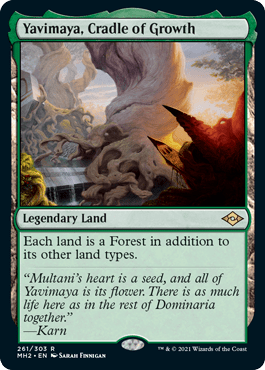
You also need a good number of Forests for using with Utopia Sprawl. Yavimaya, Cradle of Growth will go a long way towards helping that.

The game plan of the deck is fairly simple: every one of these forty spells is an enchantment, meaning you should be triggering your enchantresses very often. Sanctum Weaver also gives you a ton of mana to cast all the cards you’re drawing.


Sterling Grove helps you protect your enchantments from nasty removal spells and Solitary Confinement doesn’t even have a downside with all the extra cards you’re drawing.
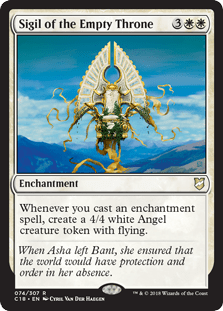
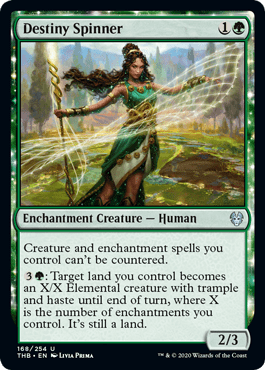
Once you’re stable, you can go in for the kill by making loads of angels using Sigil of the Empty Throne or turning your lands into giant threats with Destiny Spinner.
Honorable Mention: Bogles

Slippery Bogle | Illustration Jesper Ejsing
There were two enchantment-based decks I could have talked about, the other being Bogles. This build uses Slippery Bogle and Gladecover Scout along with a huge pile of aura spells to make massive hexproof threats that are very difficult to deal with.
A lot of the big money cards in a Bogles deck, like Daybreak Coronet, have recently dropped in price and the deck has become affordable. But it’s also branched out into blue to use Curious Obsession and Staggering Insight among others. This development makes it very difficult for me to suggest a version that would work while compromising on the mana base, so I decided to just give it an honorable mention here.
I also think Enchantress is a lot more fun to play. Who doesn’t like drawing about 20 extra cards in a game? And it’s definitely the deck I’d choose out of the two.
Blue and Black Decks
One final note is about blue and black. I gave you six possible routes to go down if you want to get started in Modern and stuck to the fairly arbitrary limit of $100, but that placed a lot of pressure on the colors I can pick. Blue and black have been pretty much off the table for a variety of reasons.
Blue Doesn’t Like to Be Alone
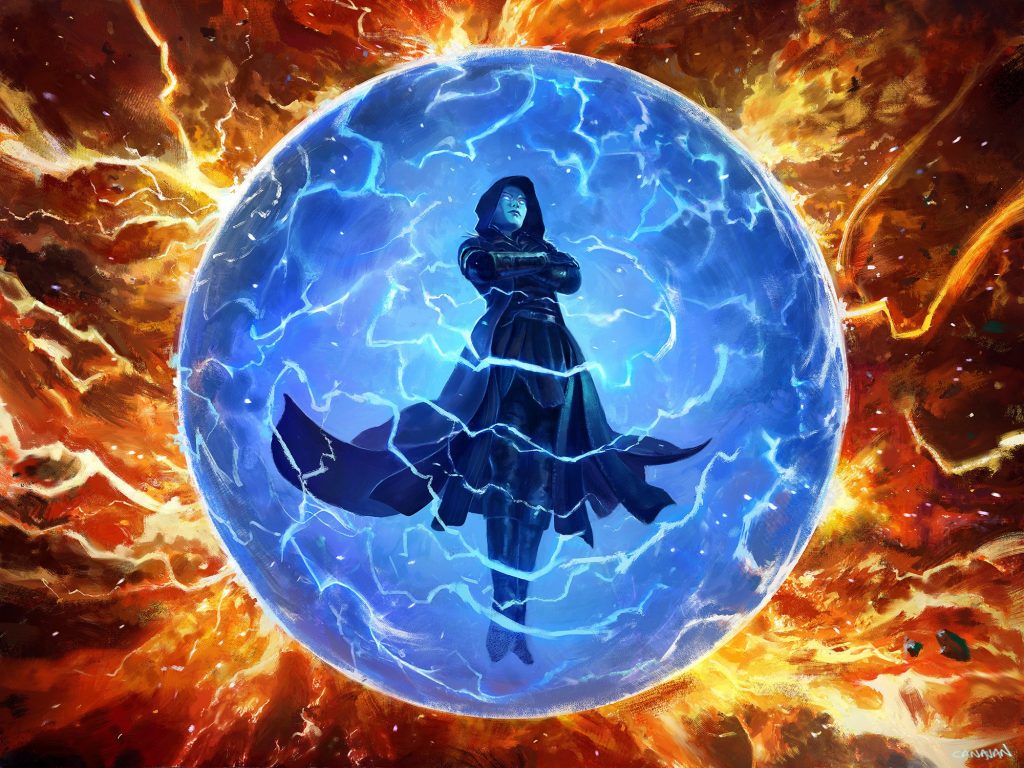
Force of Negation | Illustration by Paul Scott Canavan
Blue may be the best color in Magic’s history, but it’s not a great color for a mono-color build. At least in this format. Blue works best when paired with other colors in Modern, which is something I’ve mostly avoided doing since mana bases will break the budget.
A lot of the best blue cards in Modern are also prohibitively expensive. Cards like Force of Negation, Archmage's Charm, Jace, the Mind Sculptor, and Cryptic Command just can’t fit into the budget no matter how hard you try.
I did manage to fit in Storm as a blue deck because blue’s cantrip and draw spells tend to be very cheap, making Storm a perfect choice for a budget blue deck. Other possible options for blue included Illusion tribal, Merfolk tribal, or even a personal favorite of mine: Ninja Faeries. But you need to run something expensive to make any of these good enough to compete and I couldn’t fit that in.
Black is $$
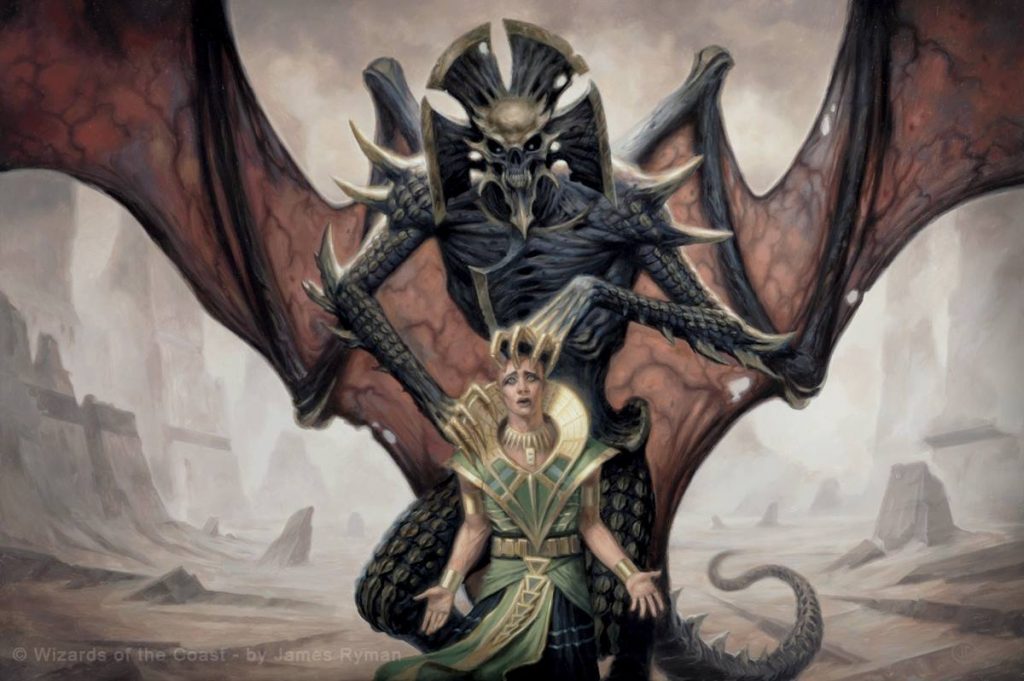
Thoughtseize | Illustration James Ryman
Black has a lot of the same problems. I could have put together a simple mono-black aggro deck, but you have to ask, “how will it compete against other Modern decks? In particular, how does it fair against disruption?”
White has lots of fairly resilient creatures, green can protect its creatures with Blossoming Defense, and red can start chucking burn spells at your opponent and can play haste creatures to get damage through. But what does black do? The answer is simple, but not cheap: it uses Thoughtseize.
Thoughtseize is one of the best black cards ever printed and is pretty vital in making sure that you can withstand the onslaught you face against powerful decks in the format. It’s also around $50 for a set, which eats up half the budget.
If I were to suggest you build an aggressive zombie or vampire deck in mono black, Thoughtseize would basically be necessary and then there’s no room for cards you really want in those decks which tend to have quite a few money rares in them. It’s true that you could get away with Inquisition of Kozilek as a cheaper alternative, but it’s just not going to cut it with cards like Solitude, Fury, and Supreme Verdict in the format.
I looked at other alternatives for black decks, like Food decks based around Asmoranomardicadaistinaculdacar and her cookbook, or affinity decks based around Blood Fountain, Thought Monitor, and Thoughtcast, but they also had a significant money card that wasn’t cuttable: Urza's Saga.
Saga is the biggest payoff for all of these decks and the most important win condition in some cases. You can get away with a cheaper mana base when starting out with a 2-color deck, but when your $30 land is one of your deck’s primary win conditions, you have a little problem cutting it. But these decks are definitely something you can look into and probably very doable for about $200 to $250 if your budget is a little bigger than my $100 limit.
Wrap Up

Dramatic Finale | Illustration by Steve Argyle
There was a time when I couldn’t stand playing Modern, but now it’s one of my favorite formats. There’s such a wonderful diversity of decks and styles to play, and if you’re reading this thinking you’d like to get started in the format, then that’s awesome. I know it can be daunting to start when you’re on the outside looking in but believe me, it won’t be long before you’re in there and hooked!
I want to thank everyone who’s read this piece and anything else I’ve written here on Draftsim. This has been a great experience to share my knowledge with you all and I’m looking forward to what I can bring you in 2022. If you're looking for more Draftsim content, make sure to find us over on Twitter.
I’ll see you in the next one!
Follow Draftsim for awesome articles and set updates: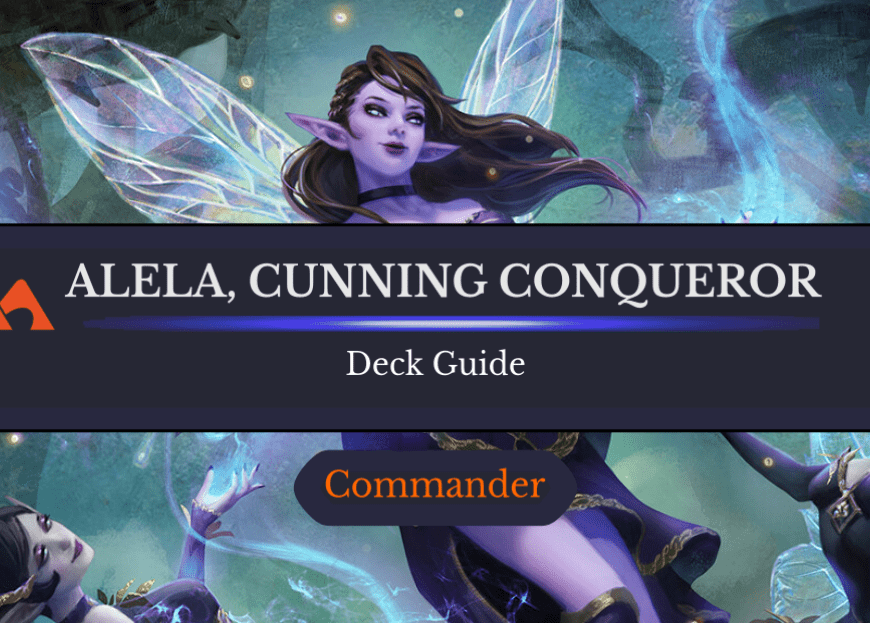
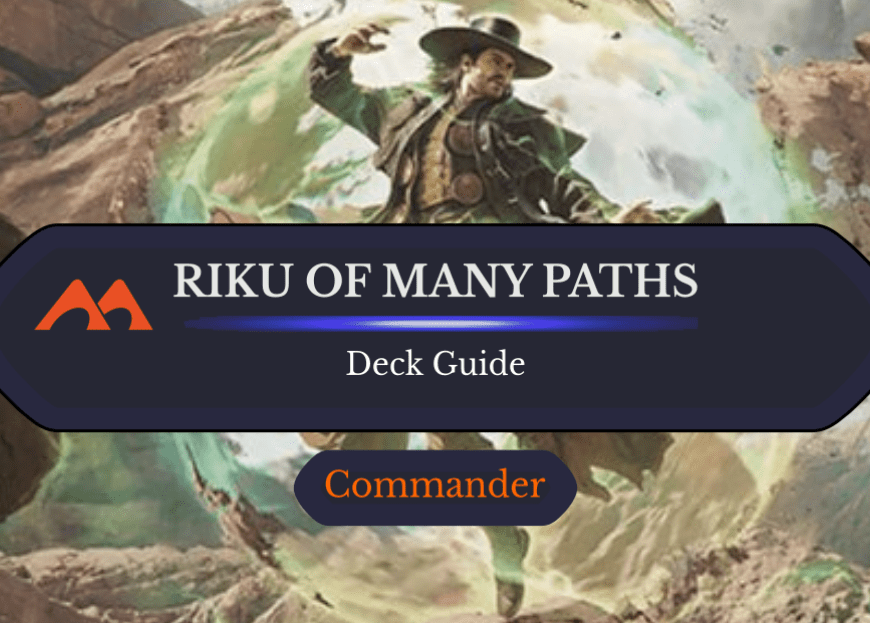
Add Comment